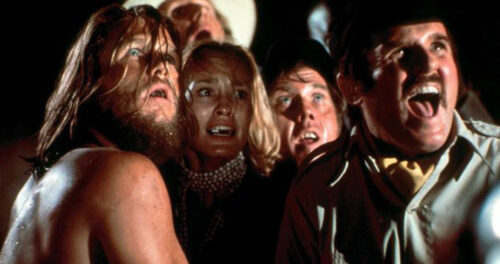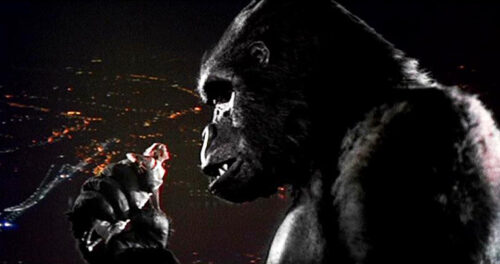[6]
After the world saw its first bona-fide blockbuster, 1975’s Jaws, daring Italian movie mogul Dino De Laurentiis decided he needed to go down in history for producing the second one. He settled on a remake of 1933’s King Kong and hired John Guillerman (The Towering Inferno) to direct. The screenplay is faithful to the original film in its broad strokes: A boat seeks passage to a secret island where prehistoric creatures are thought to exist. Once there, the natives kidnap the lone female of the group and offer her to the all-mighty Kong, who doesn’t want to eat or kill her so much as he wants to keep her as a pet. Once she’s rescued by the others, Kong is kidnapped and brought back to New York where all Hell breaks loose.
Jessica Lange makes her film debut as Faye Wray’s counterpart. The part is written to be a bit of a bimbo. Lange seems to struggle with the role until she’s with Kong, fearful and bewildered. Jeff Bridges, not yet quite a star, plays the male lead, a long-haired hippie scientist who stows away on the trip to study the island’s creatures. The original film’s protagonists were filmmakers looking to capture jaw-dropping footage, but the remake pits Bridges’ ecological concerns against the capitalistic ambitions of a smarmy oil executive, played somewhat comedically by Charles Grodin. All of these performers are upstaged by Kong — but not necessarily in a bad way.

One of the few ways this version improves upon the original is in the expressiveness of its namesake. De Laurentiis hired effects guru Carlo Rambaldi to create a life-size, full-body robotic Kong and promised this creation throughout the film’s pre-release marketing. But the giant robot was so unconvincing, it appears only briefly in a couple of shots. What worked far more convincingly was simply a man in a monkey suit. That man was now-legendary effects artist Rick Baker, in a suit that he designed, with animatronics created by Rambaldi. Though Baker is wearing scleral contact lenses, its his eyes that provide a window into Kong’s soul.
Baker’s work, combined with a romantic score by John Barry, gives this King Kong a little more emotional resonance at times. But a love affair between a woman and a big ape can only go so far. Scenes of Kong trying to disrobe Lange’s character and using his mouth to blow-dry her after a bath come off awkwardly hilarious. Even more unconvincing are the pre-Star Wars optical compositing effects in the film’s famous climax between Kong and armed helicopters. Of all the scenes for the remake to fall especially short, it’s a shame that it had to be the skyscraper finale.
Wherever it falters, though, this King Kong is never dull. Exotic locations and Oscar-nominated cinematography add to its luster. And I admire the ambition behind it — created at a time when Hollywood was still figuring out how to make and release what was coming to be known as the “blockbuster”, or what is now called a “tent-pole event”. With Rene Auberjonois, Ed Lauter, John Randolph, and Jack O’Halloran.
Academy Award: Best Visual Effects
Oscar Nominations: Best Cinematography (Richard Kline), Sound

